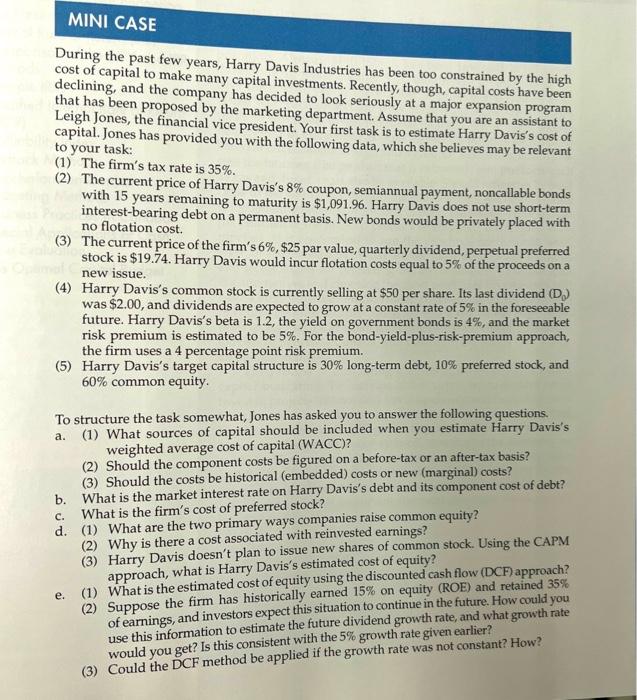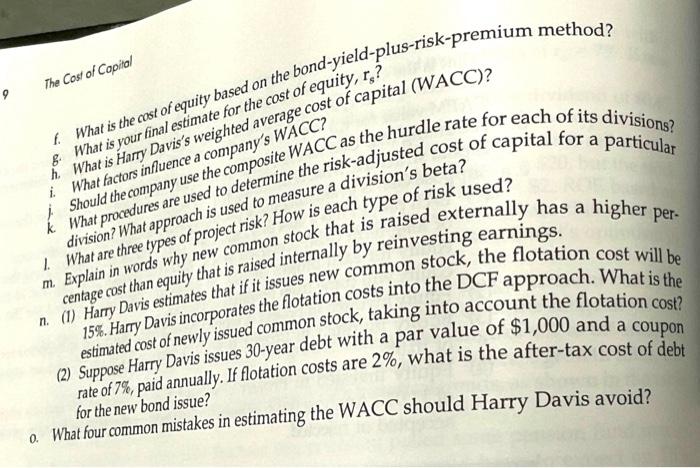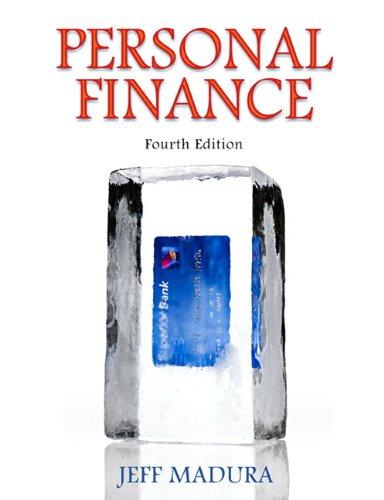MINI CASE During the past few years, Harry Davis Industries has been too constrained by the high cost of capital to make many capital investments. Recently, though, capital costs have been declining, and the company has decided to look seriously at a major expansion program that has been proposed by the marketing department. Assume that you are an assistant to Leigh Jones, the financial vice president. Your first task is to estimate Harry Davis's cost of capital. Jones has provided you with the following data, which she believes may be relevant to your task: (1) The firm's tax rate is 35%. (2) The current price of Harry Davis's 8% coupon, semiannual payment, noncallable bonds with 15 years remaining to maturity is $1,091.96. Harry Davis does not use short-term interest-bearing debt on a permanent basis. New bonds would be privately placed with no flotation cost. (3) The current price of the firm's 6%,$25 par value, quarterly dividend, perpetual preferred stock is $19.74. Harry Davis would incur flotation costs equal to 5% of the proceeds on a new issue. (4) Harry Davis's common stock is currently selling at $50 per share. Its last dividend (D0) was $2.00, and dividends are expected to grow at a constant rate of 5% in the foreseeable future. Harry Davis's beta is 1.2, the yield on government bonds is 4%, and the market risk premium is estimated to be 5%. For the bond-yield-plus-risk-premium approach, the firm uses a 4 percentage point risk premium. (5) Harry Davis's target capital structure is 30% long-term debt, 10% preferred stock, and 60% common equity. To structure the task somewhat, Jones has asked you to answer the following questions. a. (1) What sources of capital should be included when you estimate Harry Davis's weighted average cost of capital (WACC)? (2) Should the component costs be figured on a before-tax or an after-tax basis? (3) Should the costs be historical (embedded) costs or new (marginal) costs? b. What is the market interest rate on Harry Davis's debt and its component cost of debt? c. What is the firm's cost of preferred stock? d. (1) What are the two primary ways companies raise common equity? (2) Why is there a cost associated with reinvested earnings? (3) Harry Davis doesn't plan to issue new shares of common stock. Using the CAPM approach, what is Harry Davis's estimated cost of equity? e. (1) What is the estimated cost of equity using the discounted cash flow (DCF) approach? (2) Suppose the firm has historically earned 15% on equity (ROE) and retained 35% of earnings, and investors expect this situation to continue in the future. How could you use this information to estimate the future dividend growth rate, and what growth rate would you get? Is this consistent with the 5% growth rate given earlier? (3) Could the DCF method be applied if the growth rate was not constant? How? The cost of Copiol f. What is the cost of equity based for the cos the bond-yield-plus-risk-premium method? 8. What is your final est's weighted average cost of capital (WACC)? h. What is Harry influence a company i. What factors in shouny use the compormine the risk-adjus's beta? - What procedures are used to ded to measure a dived ty of risk used? division? What approach is of risk? How is each that is raised externally has a higher per- 1. What are three types of now common stock that is rainvesting earnings. m. Explain in words why that is raised internally common stock, the flotation cost will be centage cost than equily thates that if it issues new com int of the DCF approach. What is the n. (1) Harry Davis Davis incorporates the flotation costaking into account the flotation cost? estimated cost of newly issued common stock with a par value of $1,000 and a coupon (2) Suppose Harry Davis issues 30-year debt costs are 2%, what is the after rate of 7%, paid annually. If flotation costs are 2%, what is the David? for the new bond issue? 0. What four common mistakes in estimating the WACC should Harry Davis MINI CASE During the past few years, Harry Davis Industries has been too constrained by the high cost of capital to make many capital investments. Recently, though, capital costs have been declining, and the company has decided to look seriously at a major expansion program that has been proposed by the marketing department. Assume that you are an assistant to Leigh Jones, the financial vice president. Your first task is to estimate Harry Davis's cost of capital. Jones has provided you with the following data, which she believes may be relevant to your task: (1) The firm's tax rate is 35%. (2) The current price of Harry Davis's 8% coupon, semiannual payment, noncallable bonds with 15 years remaining to maturity is $1,091.96. Harry Davis does not use short-term interest-bearing debt on a permanent basis. New bonds would be privately placed with no flotation cost. (3) The current price of the firm's 6%,$25 par value, quarterly dividend, perpetual preferred stock is $19.74. Harry Davis would incur flotation costs equal to 5% of the proceeds on a new issue. (4) Harry Davis's common stock is currently selling at $50 per share. Its last dividend (D0) was $2.00, and dividends are expected to grow at a constant rate of 5% in the foreseeable future. Harry Davis's beta is 1.2, the yield on government bonds is 4%, and the market risk premium is estimated to be 5%. For the bond-yield-plus-risk-premium approach, the firm uses a 4 percentage point risk premium. (5) Harry Davis's target capital structure is 30% long-term debt, 10% preferred stock, and 60% common equity. To structure the task somewhat, Jones has asked you to answer the following questions. a. (1) What sources of capital should be included when you estimate Harry Davis's weighted average cost of capital (WACC)? (2) Should the component costs be figured on a before-tax or an after-tax basis? (3) Should the costs be historical (embedded) costs or new (marginal) costs? b. What is the market interest rate on Harry Davis's debt and its component cost of debt? c. What is the firm's cost of preferred stock? d. (1) What are the two primary ways companies raise common equity? (2) Why is there a cost associated with reinvested earnings? (3) Harry Davis doesn't plan to issue new shares of common stock. Using the CAPM approach, what is Harry Davis's estimated cost of equity? e. (1) What is the estimated cost of equity using the discounted cash flow (DCF) approach? (2) Suppose the firm has historically earned 15% on equity (ROE) and retained 35% of earnings, and investors expect this situation to continue in the future. How could you use this information to estimate the future dividend growth rate, and what growth rate would you get? Is this consistent with the 5% growth rate given earlier? (3) Could the DCF method be applied if the growth rate was not constant? How? The cost of Copiol f. What is the cost of equity based for the cos the bond-yield-plus-risk-premium method? 8. What is your final est's weighted average cost of capital (WACC)? h. What is Harry influence a company i. What factors in shouny use the compormine the risk-adjus's beta? - What procedures are used to ded to measure a dived ty of risk used? division? What approach is of risk? How is each that is raised externally has a higher per- 1. What are three types of now common stock that is rainvesting earnings. m. Explain in words why that is raised internally common stock, the flotation cost will be centage cost than equily thates that if it issues new com int of the DCF approach. What is the n. (1) Harry Davis Davis incorporates the flotation costaking into account the flotation cost? estimated cost of newly issued common stock with a par value of $1,000 and a coupon (2) Suppose Harry Davis issues 30-year debt costs are 2%, what is the after rate of 7%, paid annually. If flotation costs are 2%, what is the David? for the new bond issue? 0. What four common mistakes in estimating the WACC should Harry Davis








